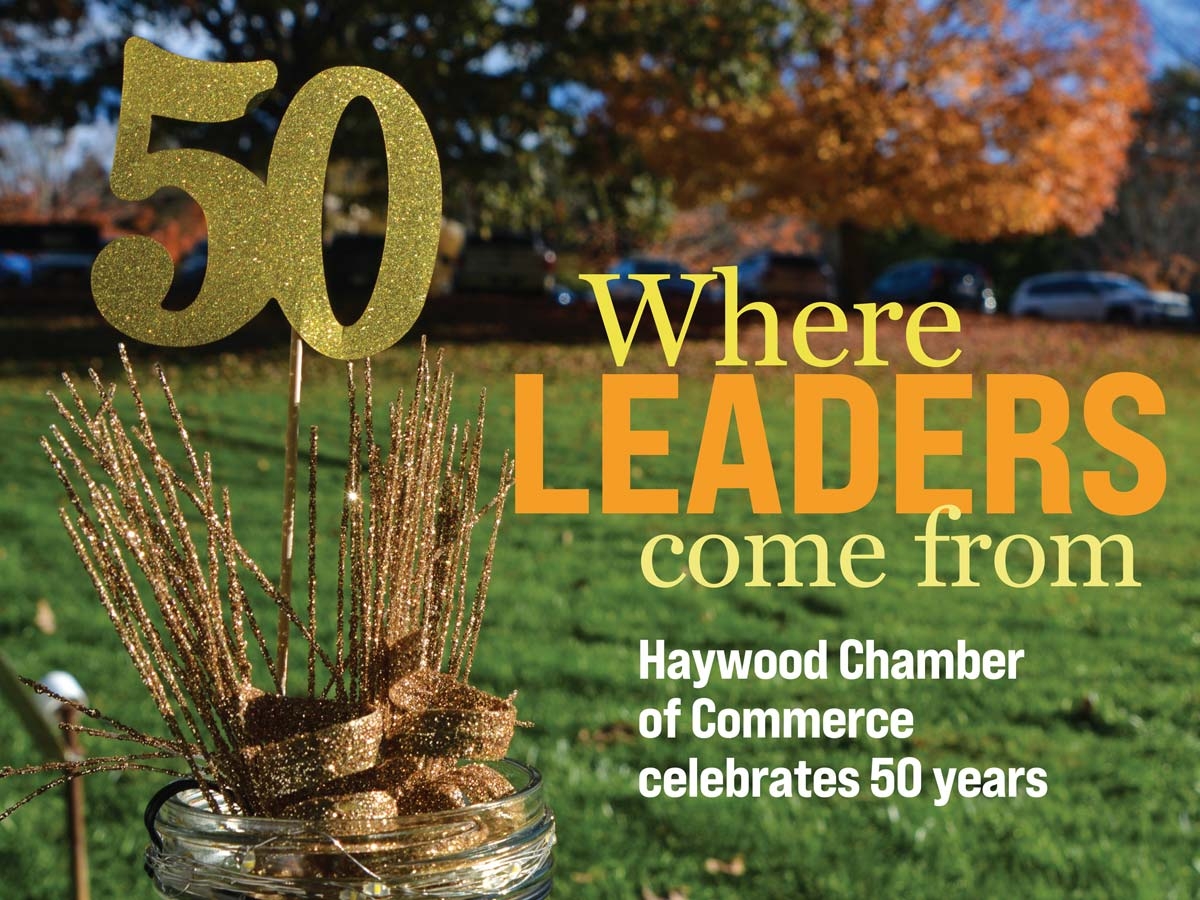Haywood Chamber celebrates 50 years of development, engagement

It’s not the first thing people usually think of when they try to recount the relative prosperity of a community over generations.
Usually, it’s the politicians, the policies and the personalities behind the progress that get the headlines, but oftentimes underlying them all is an ancient institution that everyone knows about, but few truly know: the local chamber of commerce.
As a voluntary association of businesses advocating for interests that ultimately intersect with the public good, modern chambers of commerce can be said to engage in the business of development — of both the local economy and the people who support it.
For the past 50 years, the Haywood County Chamber of Commerce has been a central part of that effort and is responsible for millions in investment and thousands of jobs.
But with 50 years of lessons learned, the Haywood chamber remains intent on developing the leaders who will learn from those lessons and apply them to the next 50 unpredictable years.
While chambers of commerce are now ubiquitous — there are more than 13,000 across the world and at least 4,000 in the United States alone — it wasn’t always that way.
Related Items
Chambers of commerce trace their roots to medieval trade guilds that acted to regulate trade and to interface with other guilds in promoting businesses in a specific town, county or region.
The first true Chamber of Commerce was founded in Marseilles, France, in 1599 when the municipal government found it could no longer manage both civic and commercial affairs at the same time.
According to The Magicians of Main Street , a comprehensive history of America’s chambers of commerce written by Chris Mead in 2014, the Chambre du Commerce de Marseille was involved in harbor maintenance, commissioning trade delegations and even roving pirate abatement.
Almost three centuries later, the Chambre du Commerce would play a critical role in building the Suez Canal. The canal, which would revolutionize maritime trade across Europe, wasn’t the first example of a chamber of commerce intervening in such big-picture business issues; a chamber founded in Paris shortly after the one in Marseille gave critical backing to Samuel de Champlain as he pushed for growth in the infant settlement of French Canada during the 17th century.
America’s first chambers of commerce were founded just before the American Revolution, in New York and Charleston, South Carolina, although similar groups had existed in Boston since the 1730s. After a brief interregnum owing to the war, chambers of commerce began to spring up across this new nation, in places like New Haven and Hartford, Connecticut, and Lexington, Kentucky.
Chamber creation boomed during the 1800s as major commercial centers (usually with ports) like Savannah, Georgia, New Orleans, Chicago and Detroit established their own.
Wilmington became the first chamber of commerce in North Carolina in 1853, followed by New Bern in 1866, Charlotte in 1870, Greensboro in 1877, Winston-Salem in 1885, Goldsboro in 1887, Raleigh in 1888 and Asheville in 1898.
Mead’s book relates an interesting anecdote regarding Asheville’s chamber that illustrates the many areas in which chambers of the time worked to promote commercial interests within their jurisdictions.
In 1927, a man visiting the town complained about the lack of “old-time music” and was then encouraged to bring some musicians to the Asheville chamber’s Rhododendron Festival.
That man was legendary Appalachian fiddler Bascom Lamar Lunsford, and with him were the Soco Gap Square Dancers — a Maggie Valley group led by Haywood County’s own Sam Love Queen credited with introducing clogging to the world.
The first known mention of any local chamber of commerce west of Asheville comes in the Feb. 3, 1921, issue of The Carolina Mountaineer and Waynesville Courier. According to the story, an evening rally hosted by the Canton Chamber of Commerce kicked off late because guests coming in from Asheville got their car stuck in the mud.
At some point around this time, the Canton chamber merged with the Bethel Chamber of Commerce to become the Canton-Bethel Chamber of Commerce.
Over the ensuing decades, separate chambers were established in Clyde and Waynesville, which served areas from Balsam to the edge of Clyde.
The Maggie Valley Chamber of Commerce’s Facebook page says it was established in 1963, but newspaper reports place its founding decades earlier than that. By the early 1970s, the larger, more professional chambers had begun talks on consolidation, to take advantage of economies of scale and promote the county as a whole, rather than as individual slivers of competing economies.
On Jan. 12, 1971, the Waynesville Area Chamber of Commerce changed its name to the Greater Haywood Chamber of Commerce, in anticipation of a consolidation with Clyde and Canton-Bethel.
At the same time, the respective boards of directors led by Canton-Bethel president L.A. Coman, Jr. and Greater Haywood president W.H. Anderson unanimously approved a study geared toward achieving unification.
In the fall of 1971, that unification became a reality, bringing together all but the Maggie Valley chamber under one banner.

The Greater Haywood Chamber’s logo, circa 1972. File photo
“It is going to mean work, understanding and cooperation,” reads an editorial in the Oct. 4, 1971 issue of the Waynesville Mountaineer. “And what is hard about any of the three? Haywood has been, and still is, the envy of many counties. We think it is largely because we strive to work together and attain success in outstanding programs.”
Today, the Haywood Chamber of Commerce continues that work on a budget of less than $200,000 a year, not quite double that of the 1971 Waynesville chamber’s inflation-adjusted $123,000. Although chamber membership fluctuates, it’s usually in the range of 400 to 500 businesses.
Most of the Haywood chamber’s revenue comes from dues, sponsorships and events. The Apple Harvest Festival is the biggest and will next year celebrate its 35th anniversary. There’s also a yearly golf tournament and an annual dinner.
Other revenue comes from a plethora of programs designed not as revenue generators but instead as community networking events intended to encourage the next generation of Haywood County’s commercial and civic leadership.
There’s a group called Young Professionals of Haywood that meets on a regular basis, as well as a group headed by local entrepreneur/writer Wendy Forbes, called Women Enlightened . A monthly Issues and Eggs series brings in regular speakers to keep the community apprised of important topics in the region, and the yearly Leadership Haywood program provides 9 months of intensive instruction with a local focus on topics as varied as history, the environment, economic development, law enforcement and state and municipal government.
But the Haywood chamber’s development into a community-wide resource didn’t just happen overnight; instead, for nearly two decades, it’s been nurtured under the watchful leadership of a transformative figure in the history of Haywood County’s own development.

Longtime Haywood Chamber President Cece Hipps speaks at a recent 50th anniversary gathering. Cory Vaillancourt photo
From her desk inside a handsome 1920s-era Waynesville mansion on Walnut Street, Haywood Chamber of Commerce President CeCe Hipps has guided the chamber through some of its most challenging periods.
Hipps arrived in 2004, shortly before devastating floods ravaged the county. Four years later, in 2008, a recession borne on the back of a bursting bubble in the housing market ensued. More than a decade after that, as the economic damage from the Great Recession was finally in the rear-view mirror, a once-a-century global pandemic shuttered businesses across the country. The next year, another devastating flood.
Still, Hipps’ Haywood chamber has scored some important victories over those 17 years, in conjunction with the late Mark Clasby’s economic development expertise.
“Definitely the Dayco project — turning that into a mega-retail center for us,” Clasby told The Smoky Mountain News in August 2017. “Phase one was the Walmart and the Best Buy, and phase two was the Belk’s, Michael’s and PetSmart. They’ve been very successful.”
In late 2017, the Haywood chamber and the Haywood Economic Development Commission entered into an innovative partnership with the much larger (and older) Asheville chamber to approach economic development in concert, rather than in competition.
“The Haywood Chamber of Commerce really exists to be a resource, a catalyst for growth and economic development among the business community here in Haywood County,” said Dr. Michael Coleman, chair of the Haywood Chamber of Commerce’s board of directors since this past July. “Economic development and the chamber go in tandem with one another.”
The partnership leverages the cache of trendy, well-known Asheville for the benefit of its lesser-known neighbors in Haywood County; economic development sites in Haywood are marketed alongside those in Buncombe.
While producing a noticeable uptick in the amount of interest in Haywood among national and international companies, the partnership has also resulted in two notable victories from right here in Western North Carolina.
“Small business, for example, is so important to our economy both nationally and here locally,” Coleman said. “We need to make sure on a continual basis that our local elected officials understand that and continually strive to help this area and help our surrounding areas with growth and economic development opportunities.”
One is the expansion of Frog Level’s Giles Chemical, which Hipps said had been exploring an expansion outside the region.
“The other is [Franklin-based] Drake Software , which was about a three-year process,” Hipps said. “We’ve been working on Drake for a long time, which is a really good thing for us.”
In the field of economic development, the mantra is simple — grow or die.
Growth requires consistent, coherent messaging to state and federal leaders. In fact, one of the newly-merged chamber’s efforts in 1971 involved lobbying the state for an additional vehicle tag facility in Waynesville to augment the county’s only office in Canton. Another, throughout the 1970s, focused on improving local roads as an expedient to commercial and recreational activity.
That cooperation endures, as local businesses and municipal governments continue to navigate the state and federal processes associated with flood recovery. Simultaneously, Coleman said that because of the Coronavirus Pandemic, the Haywood chamber has been taking the time to reevaluate nearly every aspect of its operations to ensure they are and will continue to be relevant in a world forever changed by COVID-19.
Into that world heads the Haywood chamber, presumably for another 50 years, and more beyond that. Based on the calamities Hipps has had to weather during her time here — as well as those victories — the chamber of the future needs to be prepared for any economic eventuality.
“I don’t have a crystal ball, but there’s always a vision going forward of what you want to achieve in a community,” she said.
Workforce development is a key component of that, says Hipps, and creating quality jobs is an essential goal for this tourism-based service economy that experiences a good amount of “brain drain” — young, educated people forced to leave the county or region due to a lack of opportunity befitting their credentials and experience.
“I think we need to continue to develop leaders within the community. That’s why I started the Young Professionals, the Women Enlightened, the Leadership Haywood program — to grow and develop these young leaders and provide them with the opportunity to get engaged with the community,” she said. “Because engagement in the community is where the leaders come from.”









